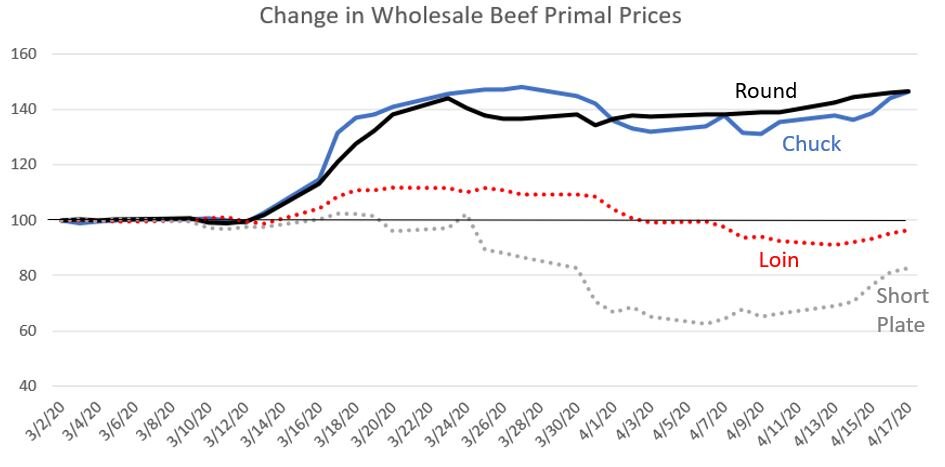There has been a lot of recent discussion about the impact of COVID-19 on food prices and availability. The recent closure of several meat packing plants has focused attention on meat prices in particular. There is a tendency to lump all cuts together as “pork” or “beef,” but as we’ll soon see, price impacts can differ significantly depending on which types of pork or beef we’re talking about.
First, let me state the obvious. Animals come in fixed proportions. A cow has 4 legs, 2 ears, and 1 tail. Likewise, meat from a cow comes from seven primary anatomical regions (these are the beef “primals”). One of the primals is the chuck, which comes from the front, shoulder area. About half the chuck typically goes to producing ground beef, and the other part primarily goes to roasts. It is possible to cut “steaks” out of the chuck, but they tend to be lower quality. By contrast, the rib and loin primals (along the back of the animal) contain the high dollar steaks (ribeyes, strip steaks, tenderloin). It is possible, of course, to turn a tenderloin into ground beef, but typically one would be crazy to do it because steaks from a tenderloin sell at double, triple, or quadruple the price of ground beef.
Ok, now what happened to the wholesale prices of primals in the wake of COVID stay-at-home measures? The figure below shows changes in prices of four beef primals relative to the their prices at the beginning of March.
Apparently, all beef isn’t created equal. The prices of round and chuck have increased more than 40% since the beginning of March. These are the primals that tend to be lower priced and are more frequently used to create roasts and ground beef. As it turns out, these are also the beef cuts consumers can afford and are more easily able to utilize at home, and the cuts seem to have benefited from the shift in meat buying from restaurants to groceries. By contrast, loin prices fell about 9% before rebounding a bit. We apparently eat more steaks when we have the money and ability to eat away from home. The price of the “short plate” fell about 30% before rebounding to “only” a 17% decline. This primal includes cuts like the skirt steak that are frequently used to make fajitas and part of the brisket; cuts heavily used in Mexican and BBQ restaurants.
We can see a similar story for pork. All pork isn’t created equal. There are six pork primals. The figure below shows price changes for four of the primals since early March. The prices of bellies and hams fell more than 50% before recovering somewhat. Bellies, of course, are the source of bacon. Apparently, bacon is eaten much more away from home than at home. The trends for ham and butt (inaccurately named because the pork butt actually comes from the shoulder) are a bit harder to explain, but interestingly, pork loin prices increased and remained fairly steady, now selling about 50% higher than at the beginning of March.
Why did prices of pork loins respond so differently than beef loins? It may be the price point. On April 17, 2020 the wholesale price of pork loin was about $0.92/lb, whereas the wholesale price of beef loin was about $2.62/lb.

